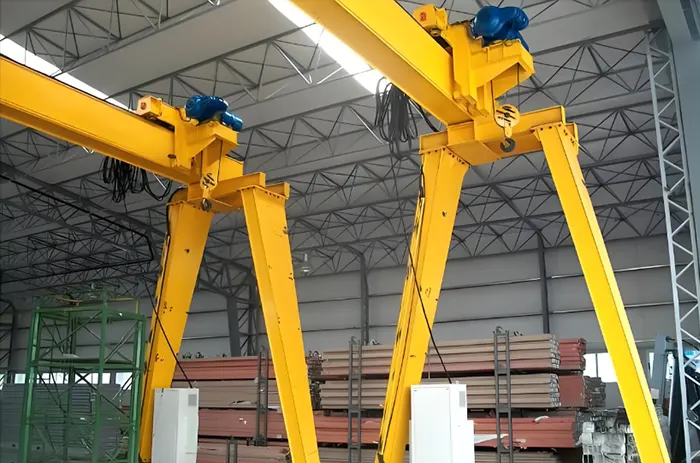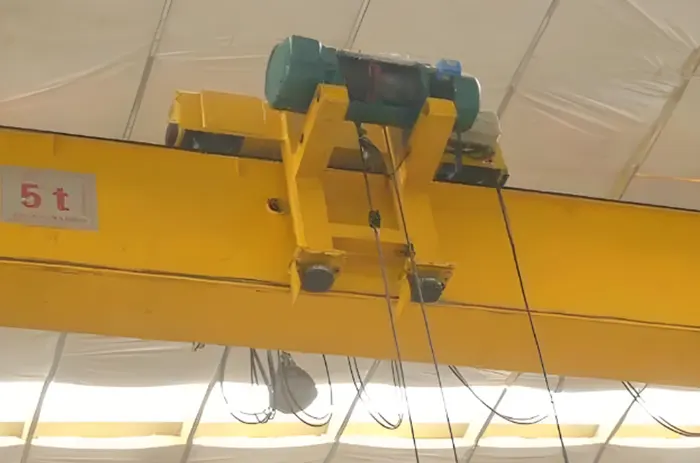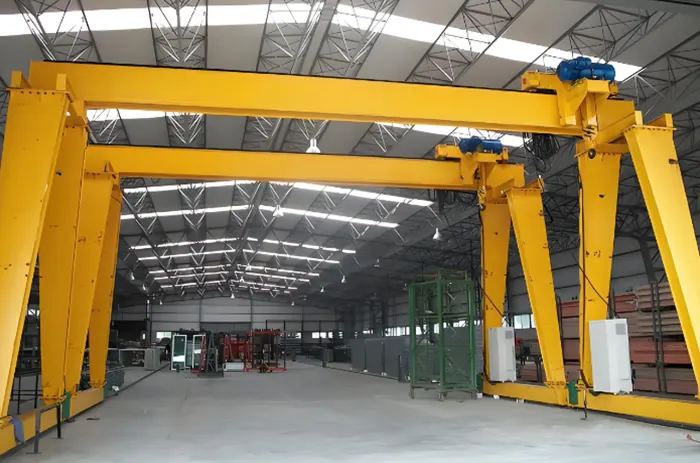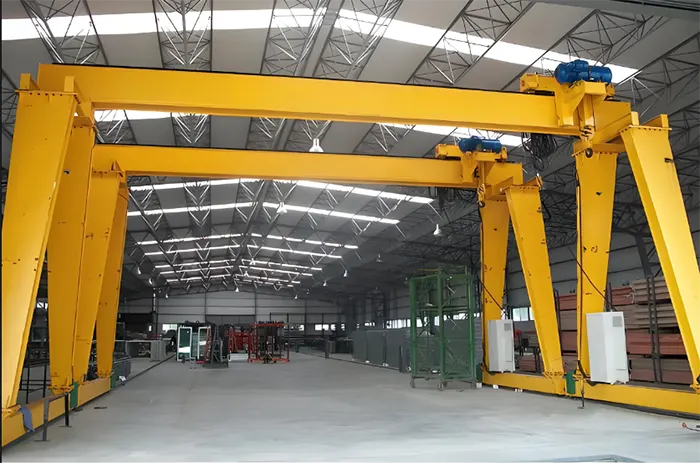Compact gantry crane with low headroom design and eccentric hoist trolley, ideal for tight spaces & efficient lifting.Get your low headroom gantry crane!
Overview of Single Girder Gantry Cranes
Single girder gantry cranes are versatile lifting systems used across various industries. They feature a single overhead beam supported by legs on either side, allowing them to move loads horizontally within a defined space. These cranes are valued for their ability to handle heavy loads efficiently and their flexibility in adapting to different operational needs.
Low headroom single girder gantry cranes are designed to optimize vertical space in workshops or warehouses. By reducing the height of the crane’s overhead components, these cranes allow for greater lifting heights and better use of available space. This design is ideal for environments with limited headroom or where maximizing usable space is essential for improving productivity.
An eccentric hoist trolley is a specialized component used with single girder gantry cranes, where the hoist is mounted off-center. This setup helps balance loads with uneven weight distribution and enhances maneuverability in tight spaces. Eccentric hoist trolleys improve the crane’s ability to handle loads with greater precision and flexibility.

Features of Low Headroom Single Girder Gantry Cranes
Design and Structure
- Single Girder Configuration:Single girder gantry cranes feature a single overhead beam supported by vertical legs on either side. This design simplifies the crane’s structure while still providing robust lifting capabilities. The single girder configuration allows for lighter and more compact cranes compared to double girder models, making them ideal for environments with space constraints or lower lifting height requirements.
- Low Headroom Advantages :Low headroom design minimizes the height of the crane’s overhead components, such as the girder and hoist. This feature is crucial for maximizing vertical space in areas with limited headroom, enabling greater lifting heights and efficient use of space. By reducing the crane's overall height, businesses can utilize more of their vertical space for storage or other operations, leading to increased productivity.
Operational Efficiency
- Space Optimization:Low headroom single girder gantry cranes are designed to make the most of the available space in a workshop or warehouse. By reducing the crane’s height, these models allow for higher lifting heights and more efficient use of the vertical space, which is especially beneficial in environments where maximizing usable space is critical.
- Enhanced Maneuverability:The compact design of low headroom single girder gantry cranes improves their maneuverability. With a smaller overhead profile, these cranes can navigate tighter spaces more easily, making them well-suited for workshops with limited room for equipment. This enhanced maneuverability also facilitates precise load handling and efficient movement within confined areas.
Typical Applications
- Industries and Workshops: Low headroom single girder gantry cranes are versatile and used in various industries including manufacturing, construction, and logistics. They are ideal for workshops with limited vertical space or where precise load positioning is required. Their compact design makes them suitable for environments where traditional cranes might be too large or cumbersome.
- Specific Use Cases: These cranes are commonly used for tasks such as lifting and moving heavy equipment, materials handling in small to medium-sized facilities, and assembly operations where space is at a premium. They are also effective in warehouses and maintenance areas where optimizing headroom and space is essential for operational efficiency.
Eccentric Hoist Trolley Overview
What is an Eccentric Hoist Trolley?An eccentric hoist trolley is a type of hoist trolley where the hoist is mounted off-center, or eccentrically, relative to the trolley's axis. This design allows for adjustments in load positioning and balance by shifting the hoist’s placement, which can be particularly useful for handling loads with uneven weight distribution. The eccentric configuration enables precise control and movement of loads, making it ideal for applications where balance and accuracy are crucial.

Advantages of Eccentric Design
- Load Handling Efficiency:The eccentric design of the hoist trolley enhances load handling efficiency by allowing better control over loads with irregular weight distribution. By offsetting the hoist, operators can adjust the load’s center of gravity more effectively, reducing the risk of tipping or swaying. This results in smoother and more precise lifting and moving of materials, improving overall operational efficiency.
- Space Utilization Benefits:Eccentric hoist trolleys help optimize space utilization in environments where maneuverability is limited. The off-center design enables the crane to operate in tighter spaces and reach areas that may be difficult for standard hoist trolleys. This feature is particularly advantageous in workshops or warehouses with constrained working areas, as it allows for better use of available space and improved access to specific locations.
Comparison with Standard Hoist Trolleys
- Performance Differences:Compared to standard hoist trolleys, eccentric hoist trolleys offer enhanced control and adaptability. Standard trolleys have a central hoist mount, which can limit their effectiveness in handling unevenly distributed loads. Eccentric trolleys, on the other hand, provide more precise load positioning and balance, making them better suited for applications requiring fine adjustments and stability.
- Application Suitability:Eccentric hoist trolleys are ideal for specialized applications where load distribution and space constraints are critical factors. They excel in environments where loads need to be moved with high precision and where space is limited. In contrast, standard hoist trolleys are generally suitable for more straightforward lifting tasks where load distribution is less of a concern.
Benefits of Combining Single Girder Gantry Crane Low Headroom Design with Eccentric Hoist Trolley
Enhanced Space Utilization, Maximizing Workshop Vertical Space
The synergy of a low headroom design with an eccentric hoist trolley significantly optimizes workshop space. The low headroom design reduces the crane's overall height, allowing more of the vertical clearance to be used for storage or other operations. This design is particularly advantageous in environments where every inch of vertical space is crucial. The eccentric hoist trolley complements this by allowing precise adjustments in load positioning, further maximizing the efficient use of available space and ensuring that the crane can operate effectively within confined areas.
Improved Load Handling, Better Balance and Precision
Integrating an eccentric hoist trolley with a low headroom single girder gantry crane enhances load handling by offering superior balance and precision. The eccentric design enables fine-tuning of load distribution, which helps to maintain stability and prevent tipping. This increased control translates into more accurate load positioning and smoother operation. The improved balance reduces the risk of accidents and damage to both the crane and the load, leading to more reliable and efficient performance.
Operational Flexibility
Adaptability to Various Workshop Layouts
The combination of a low headroom design and an eccentric hoist trolley provides exceptional operational flexibility. The low headroom design allows the crane to fit into spaces with restricted vertical clearance, while the eccentric hoist trolley can be adjusted to handle different types of loads and fit various workshop layouts. This adaptability makes the crane suitable for a wide range of applications, from tight industrial spaces to larger workshops with specific operational needs. Businesses can customize the crane to their requirements, enhancing overall efficiency and operational effectiveness.
- Optimal Fit for Limited Vertical Space:The low headroom design of the crane is crucial for workshops with restricted vertical clearance. By minimizing the crane’s height, it ensures that maximum usable space is maintained, allowing for greater storage capacity and more room for other equipment or operations. This design is particularly beneficial in older buildings or facilities where ceiling height is a limiting factor. It allows the crane to operate effectively without requiring extensive modifications to the existing infrastructure.
- Eccentric Hoist Trolley Versatility:The eccentric hoist trolley enhances the crane’s ability to handle a variety of load types and configurations. Since the hoist can be mounted off-center, it enables precise load positioning and adjustment. This flexibility is particularly valuable in workshops where loads may vary in shape, size, or weight. The ability to shift the hoist’s position ensures that the crane can handle both small, intricate loads and larger, more cumbersome items with equal efficiency.
- Customizable for Diverse Layouts:Workshops often have unique layouts that can pose challenges for standard cranes. The combination of a low headroom design and an eccentric hoist trolley allows for greater adaptability to these varying layouts. The crane can be tailored to fit into tight spaces or adapt to irregularly shaped work areas. For example, it can be configured to work around existing machinery, shelving, or other obstructions, ensuring that the crane maximizes the available space and integrates seamlessly with the workshop’s operational flow.
- Enhanced Operational Flexibility:This adaptability extends to the crane’s ability to support diverse operational needs. In workshops where different tasks are performed, such as assembly, maintenance, or material handling, the crane’s customizable features allow it to be adjusted or reconfigured as needed. This means businesses can use the crane for multiple purposes, enhancing its utility and ensuring that it remains a valuable asset as operational requirements evolve.
- Increased Efficiency and Productivity:Overall, the adaptability provided by the low headroom design and eccentric hoist trolley translates into increased efficiency and productivity. By fitting into tight spaces and handling various loads with precision, the crane minimizes downtime and maximizes the effective use of workshop space. Businesses can achieve smoother workflow processes, reduce operational bottlenecks, and enhance overall productivity with a crane that is precisely aligned with their specific needs and workspace constraints.
Customization Options
Additional Custom Components
- Specialized Hoists:Customization options for low headroom single girder gantry cranes with eccentric hoist trolleys include the integration of specialized hoists tailored to specific lifting needs. These hoists can be designed to handle unique load types, varying capacities, or specialized materials. Custom hoists ensure that the crane meets the precise requirements of different applications, enhancing overall performance and efficiency.
- Custom Trolley Configurations:Another key aspect of customization is the ability to configure the hoist trolley to suit particular operational needs. This includes adjusting the trolley’s dimensions, weight capacity, and operational features. Custom trolleys can be designed to fit specific workshop layouts, improve maneuverability in confined spaces, or support unique load handling requirements, ensuring that the crane performs optimally in its intended environment.
Tailored Solutions for Specific Needs
- Industry-Specific Modifications:Customization also allows for modifications tailored to specific industries. Whether for manufacturing, logistics, or other sectors, industry-specific adaptations can be incorporated into the crane’s design. This may include special controls, enhanced safety features, or adjustments to meet industry regulations and standards, ensuring that the crane aligns perfectly with the demands of the sector.
- Special Operational Requirements:For workshops with unique operational needs, customization provides solutions that address these specific challenges. This could involve integrating additional safety features, improving load handling capabilities, or adapting the crane for unusual workshop layouts. By tailoring the crane to meet these special requirements, businesses can enhance operational efficiency, safety, and overall effectiveness in their daily activities.

Buying Guide
Factors to Consider
- Capacity and Load Requirements:When selecting a low headroom single girder gantry crane, it's crucial to assess the capacity and load requirements specific to your operations. Ensure the crane can handle the maximum weight of the loads you intend to lift and move. Consider future needs as well to avoid underestimating the required capacity, which could impact efficiency and safety.
- Capacity and Load Requirements:When choosing a low headroom single girder gantry crane, assessing capacity and load requirements is essential to ensure it meets your operational needs effectively. Here’s what to consider:
- Maximum Load Capacity:Determine the maximum weight of the loads the crane will need to lift and move. It’s important to select a crane that not only meets but exceeds the typical load weight to account for any unexpected increases or variations in load size. Underestimating capacity can lead to operational inefficiencies and safety risks.
- Future Load Considerations:Think about potential future needs. If your operations are expected to expand or change, consider choosing a crane with a higher capacity than your current requirements. This forward-thinking approach helps avoid the need for an upgrade or replacement in the near future, providing long-term flexibility and cost-effectiveness.
- Load Types and Distribution:Different types of loads may have varying weight distributions. Ensure that the crane’s design and capacity can handle not just the weight but also the distribution of the load. This is crucial for maintaining stability and preventing accidents. The crane should be capable of managing different load shapes, sizes, and weights efficiently.
- Safety Margins:Incorporate safety margins into your capacity planning. Ensure that the crane’s rated capacity is well above the maximum expected load to enhance safety. This extra margin helps accommodate any potential overloading issues and ensures reliable performance under varying conditions.
- Operational Efficiency:Matching the crane’s capacity to your load requirements directly impacts operational efficiency. A crane that is appropriately sized for your needs will handle loads more effectively, leading to smoother operations, reduced wear and tear on the equipment, and fewer interruptions in your workflow.
By carefully evaluating these aspects, you can select a low headroom single girder gantry crane that meets your current and future load handling needs, ensuring efficient and safe operation within your workshop.
Workshop Space and Layout
Evaluate your workshop’s space and layout to determine how a low headroom gantry crane will fit. Measure the available vertical and horizontal space to ensure the crane will operate effectively without obstruction. Consider the crane’s footprint, including its movement range and any potential constraints from existing equipment or structures.
- Assessing Vertical and Horizontal Space:To ensure a low headroom single girder gantry crane fits well within your workshop, start by evaluating both the vertical and horizontal dimensions of the space. Measure the height from the workshop floor to the ceiling or any overhead obstructions. This is crucial to confirm that the crane’s low headroom design allows it to operate without interference. Additionally, measure the width and depth of the available space to accommodate the crane’s movement and operation.
- Crane Footprint and Movement Range:Understand the crane’s footprint, which includes the area covered by the crane’s base and supports. Ensure this footprint fits comfortably within your workshop’s layout, allowing sufficient space for the crane to operate without crowding other equipment or pathways. Consider the movement range of the crane, including its ability to traverse the workshop and reach various points within the space. The crane should be able to cover the entire work area effectively, minimizing dead zones where the crane cannot reach.
- Potential Constraints:Identify any potential constraints within the workshop, such as existing equipment, storage areas, or structural elements like columns and beams. Ensure the crane’s operation will not be impeded by these constraints. For instance, verify that the crane can move freely without colliding with other machinery or obstacles. The crane’s design should account for these constraints, providing enough clearance to navigate around them.
- Integration with Existing Equipment:Consider how the crane will integrate with existing workshop equipment and workflows. Ensure there is adequate space around the crane for operators to maneuver and perform tasks safely. The crane should complement existing operations rather than disrupting them. If modifications to the workshop layout are needed to accommodate the crane, plan these changes carefully to maintain overall workflow efficiency.
- Flexibility and Future Expansion:Assess the potential for future expansion or changes in your workshop layout. If you anticipate adding new equipment or modifying the space, ensure the crane’s design can adapt to these changes. Choosing a crane with adjustable features or planning for future reconfigurations can help accommodate evolving needs and prevent operational disruptions.
By thoroughly evaluating these factors, you can ensure that the low headroom single girder gantry crane is a suitable and effective addition to your workshop, enhancing both space utilization and operational efficiency.
Budget and Cost Considerations
Budget is a significant factor when purchasing a crane. Compare the cost of different models and options, keeping in mind not just the initial purchase price but also long-term costs such as maintenance, installation, and potential customization. Ensure that the crane you choose offers good value for money and aligns with your financial constraints.
Initial Purchase Price
When purchasing a low headroom single girder gantry crane, the initial purchase price is a crucial factor. Compare the costs of different models and configurations to find one that fits your budget while meeting your operational needs. Ensure you get detailed quotations from suppliers to understand the full scope of costs involved in the purchase.
Long-Term Costs
Consider the long-term costs associated with the crane, beyond just the initial purchase. These include:
- Maintenance Costs: Regular maintenance is essential to keep the crane in good working condition. Factor in the costs of routine inspections, parts replacements, and service contracts. Cranes with more advanced features or specialized components may have higher maintenance costs.
- Installation Costs: Installation can involve significant expenses, especially if modifications to the workshop or additional setup services are required. Obtain quotes for installation services and ensure they are included in your budget.
- Customization Costs: If you need to customize the crane to fit specific operational requirements, be aware of the additional costs. Customization can include modifications to the crane’s design, special features, or integration with existing systems.
Value for Money
Evaluate whether the crane offers good value for money by assessing its features, durability, and performance in relation to its cost. A higher initial price may be justified if the crane provides superior functionality, efficiency, and longevity. Consider the total cost of ownership, including both upfront and ongoing expenses, to determine if the crane delivers long-term value.
Financial Constraints
Ensure that the crane you choose aligns with your financial constraints. Create a detailed budget that accounts for all aspects of the crane purchase, including potential unexpected costs. Look for financing options or payment plans if necessary, but make sure they fit within your budgetary limits.
Cost-Benefit Analysis
Conduct a cost-benefit analysis to weigh the benefits of the crane against its costs. Consider how the crane will impact your operations in terms of efficiency, productivity, and safety. A more expensive crane might offer features or performance improvements that can lead to greater operational gains, making it a worthwhile investment.
By carefully considering these budget and cost factors, you can make an informed decision and choose a low headroom single girder gantry crane that provides both functionality and value within your financial constraints.
Conclusion
In this guide, we’ve explored the key features and benefits of low headroom single girder gantry cranes equipped with eccentric hoist trolleys. These cranes are designed to maximize vertical space, improve load handling efficiency, and enhance maneuverability in workshops with limited headroom. The combination of a low headroom design with an eccentric hoist trolley offers significant advantages in optimizing space utilization, improving load balance, and providing operational flexibility.
When considering the purchase of a low headroom gantry crane with an eccentric hoist trolley, carefully evaluate your specific needs, including capacity requirements, workshop layout, and budget constraints. Customization options can further enhance the crane’s suitability for your operations, ensuring it meets your unique requirements. Choose a reputable supplier who offers reliable products and comprehensive support to ensure a smooth purchasing experience.
Investing in this type of crane provides several benefits, including better utilization of vertical space, improved precision in load handling, and enhanced flexibility in workshop operations. The low headroom design allows for more efficient use of space, while the eccentric hoist trolley offers greater control and adaptability for various load types and configurations. Overall, this combination results in a highly effective and versatile lifting solution that can significantly enhance operational efficiency and productivity in your workshop.





